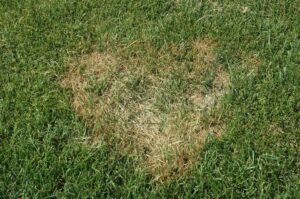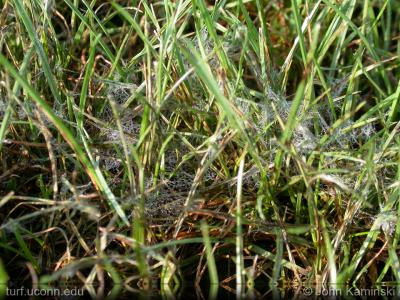Table of Contents
ToggleLast Updated on April 18, 2025
There are several different lawn diseases that plague nearly all the desirable turf species in our area. One of the most frustrating and damaging of these is caused by the dreaded pathogen rhizoctonia solani, or what we commonly refer to as brown patch. This microscopic menace can survive embedded in plant tissue or on the surface of the soil. Found nearly everywhere, the pathogen can lie in wait for extensive periods of time, even in the absence of a suitable host, just waiting for the conditions to become favorable.

When is brown patch active?
You can expect this uninvited guest anytime during the summer months. Brown patch activity begins as soon as the weather becomes hot and humid, and especially when such conditions persist through the night. The speed with which this disease starts to matriculate into residential lawns is what frustrates homeowners and lawncare operators most. Brown patch can severely blight large portions of turfgrass inside of a 6 to 8-hour period when conditions are favorable. This means you can literally wake up one morning to see large patches of discolored, wilted turf!
Turf Symptoms
In researching symptoms of this disease on the internet, this conjures a lot of images of how brown patch appears on the golf course. On low cut turf, maintained at the highest levels of fertility, halos of dark gray “smoke rings” appear on the turf making the diagnosis a no brainer. On residential lawns however, the turf kept at a 2”-3” height under moderate levels of fertility, the damage is far subtler.
The thread-like mycelium of brown patch is present in the morning dew and look very much like cob webs. These cob web structures disappear however, once the surface moisture evaporates. The damage to the turf appears as more or less circular shaped areas of tan to brown colored grass. The plants become wilted, giving the patches a sunken look to them, almost as though they have been pressed into the lawn by a strange, oversized stamp. These damaged patches can coalesce into larger areas of discolored turf as the disease continues to spread, and eventually cause thinning of the turf that requires seeding at the end of summer to repair. If there is any additional stress on the property from drought, machine traffic, insects, etc., the damage can be more extensive.

Cultural Practices in Minimizing Brown Patch
Since conditions that allow for extensive periods of leaf moisture promote this disease, especially in the overnight hours, it is critical that homeowners not create such conditions with improper irrigation. Whether using hose-end sprinklers or an in-ground irrigation system to water the lawn, the goal is always the same. Ideally, water the lawn heavily between 12am-6am so that the water penetrates the soil while the sun is not out, and any excess evaporates from the surface immediately following.
Also, give the lawn enough time in between watering, usually about 3 to 4 days, for the moisture to make its way down into the root zone before adding more water. This allows the soil surface to dry out so that oxygen can enter the pore spaces. If you water the lawn in the evening the surface remains wet from then until dawn, or you water too frequently, and the roots never can take in oxygen, this creates conditions that are perfect for brown patch. Deep, infrequent watering is the best way to prevent severe brown patch outbreak.
Low oxygen soil in general promotes brown patch activity, therefore allowing the soil to become overly compacted can also be a catalyst. Maintaining porous soil, that is as oxygenated as possible, is the best long-term cultural deterrent against brown patch. The best way to achieve this type of soil structure is with regular core aeration. Soil such as ours here in New Jersey, that is high in clay, needs to be core aerated at least every other year to maintain good structure. Annual core aeration would especially be advisable on properties with a history of frequent disease.
Brown Patch Fungicide Treatments
If brown patch outbreak does occur quickly, you should call your lawn care provider to schedule a fungicide treatment as soon as possible. If outbreaks are left unchecked, brown patch can damage the turf to the point where re-seeding becomes necessary. A timely fungicide application completed when symptoms start to appear can render the disease inactive for a few weeks. This gives the homeowner time to promote new growth through proper irrigation, so that infected portions of the grass can grow out and mowed off. It is important to point out that fungicides are not a “cure”, they are more like medicine we use when we get sick. They control the symptoms so that the patient (in this case the lawn) can fight the infection by taking care of themselves.
When we get a cold, it is bed rest and fluids that cure us from the illness, not the cough syrup. In the case of the lawn, it is making sure it has adequate soil moisture and oxygen.
Conclusion
In the end, as with almost all diseases, the better cultural care you provide for your lawn, the less likely any serious brown patch activity can arise. The more you water the lawn properly and core aerate regularly, the more equipped the turf is to fend off the barrage of fungi activity out there. Should your lawn quality start to suffer at the hands of this disease despite your best efforts, there are fungicides that can be utilized to relieve the symptoms so that the grass can be nursed back to health.
If you are located in our service area, and have questions regarding disease activity on your lawn, please give our office a call or request and estimate.

